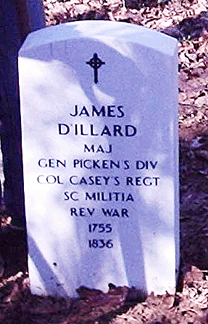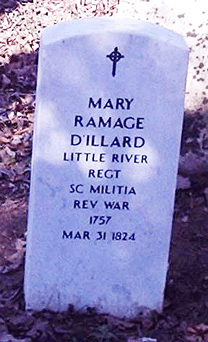|
American Heroes Honored
|
 |
 |
| Scouts and South Carolina Society Sons of the American Revolution (SCSSAR) erect new head stones. Click here. |
|
|
|
Fourth Generation
William Dillard, thought to be the son of John Dillard and Sophia ?, was born in Culpeper County VA. Evidence conflicts over his birth date. His military enlistment recorded William's birth as 1753, however, court testimony fifty years after his death points to about 1743, which is a better fit.
The Dillard property in Culpeper adjoined that of Joseph T. Norman, son of Issac Norman, and Mary Read Norman. William would eventually grow up to marry Joseph and Mary Read Norman's daughter, Mary, and father eight children.
Major "Laurens James" Dillard
Just as no discussion about William's father, John, would be complete without his brother George as a point of reference, likewise, William without brother James neglects the best part of the story.
James left Virginia at apparently a tender age for the old Ninety Six District in upland South Carolina. Like our Carlisle ancestor, James Dillard was probably lured by South Carolina's promise of land. Perhaps it was the European tradition of inheritance, which automatically awarded all property to the eldest son. Maybe assuming William would get their father's property, James, as second son, figured he would have to make his own way. His brother's 300-acres, received as a wedding gift, perhaps helped push James into leaving rather than live in the lopsided shadow of wealth his big brother would control. As we shall see, James' own gumption contributed to his decision.
James arrived in Laurens County SC about 1772 (to help distinguish this James from all the others, researchers have tagged him "Laurens James"). Just over the boundary in Newberry County, and very near Liberty Hill, which our grandfather, James Major Dillard, would own 50 years later, lived the family of John Ramage and Leah Jean Adair. Laurens James and their daughter, Mary, would soon set up housekeeping. In September of 1775, Laurens James enlists in the South Carolina State Troops to fight with Capt. Perinhoff for America's independence. After the captain's death, James served with Capt. Brown in Col. Thomson's Third Regiment. At Fort Moultrie on Apr 20, 1777, he was promoted to corporal but would be discharged just over a month later on May 31. In the spring of 1778, James reenlisted and served eight months, taking part in the Florida expedition as a sergeant major and fighting the Indians on the frontier.
In the summer of 1780, James again signs up and is elected captain to serve under Col. James Williams and Col. Joseph Hayes. A few weeks later in Virginia, his brother, William, enlists. The army's enlistment records for Sep 20, 1780 describe William Dillard as a little over five-feet, ten-inches tall and a 27-year-old farmer "with light hair and gray eyes."(although he was closer to 37). While William joins the fighting in South Carolina, Mary stays behind in Culpeper County VA and prepares to deliver the couples' eighth child.
James proves a capable soldier, but his wife, Mary, turns out to be the war hero. James and Mary's property was located near the intersection of two main Laurens County roads. In late November of 1780, "approximately two hundred" British troops stop at the Dillards demanding to be fed. Mary obliges and during supper overhears their plans for a surprise attack of Gen. Sumter's Patriots. Slipping away from the house and taking an overgrown path, Mary "loosed a horse and rode bareback until dawn," reaching Gen. Sumter's encampment at Glenn Springs near Blackstock, close to present-day Spartanburg, SC. Unaware the Patriots had been tipped off, the sneak attack on Nov 20 turns into a rout. The British fall back after losing 96 men. Patriot casualties numbered only three.
Explaining the loss later, British Gen. Ferguson and Gen. Tarleton credit a woman rider, who "observed their march along a stretch of open road" with alerting the enemy. That rider may well have been Mary Ramage Dillard, but by then, the warning had already been delivered. The Patriot victory at the Battle of Blackstock set up the "decisive British defeat" at the Battle of Cowpens six weeks later in which Laurens James fought and was wounded.
We know of only one battle in which William took part. On Sep 8, 1781, as Col. Stewart’s British troops camped near Eutaw Springs about 30 miles northwest of Charleston, SC, a squad detailed to root for sweet potatoes spotted Gen. Greene’s approaching Patriot forces. Greene believed destroying Stewart would end the British threat to the South, and had set out to take back the country. Greene marched about 2,000 Patriot troops, many ill-clad and barefoot, with the idea of preventing Stewart and Cornwallis from joining forces should Cornwallis abandon Yorktown and retreat southward. At Eutaw Springs, the Patriots were slightly outnumbered.
When the sweet potato detail hurried back with news of the approaching army, the British formed battle lines and the fighting began. The Patriots advanced, driving back the British, but soon faltered upon reaching their camp, where the impoverished troops broke ranks to plunder enemy tents for food, clothing, and whatever else they could find. The British seized the opportunity and counterattacked.
Eventually yielding to extreme weather, Gen. Greene proposed to Stewart under a white flag that the dead and wounded be attended. One of the Patriot soldiers carried from the field that day was our grandfather, William Dillard, killed either during battle or succumbing to wounds afterward. Did Laurens James take part in the battle? One important source places him there. His daughter, Nancy Boyce, wrote a letter in 1873 in which she states that her father was "at the Battle of Eutaw Springs and lost his brother William Dillard who was killed..."
Before the war and his military career ended, Laurens James would be promoted to major, fight under Gen. Pickens, and take part in battles at King's Mountain, William's Fort, Bush River, the siege of Ninety Six, and Edisto, where he was wounded. The record shows he was also twice cut by sabers during fights with the Indians.
Maybe William enlisted in the army to get away from his troubles. Twenty years after his death, a collector with British Mercantile Claims was told that William "was a dissipated man." Whether through intemperance or squander, Mary and the eight children were apparently left with nothing.
The family was said to be "in such distress after he was killed that some of his children were taken and supported . . ." The record shows that William and Mary's three eldest sons, including our grandfather, John, left Virginia and moved to South Carolina where their Uncle James lived. Did Laurens James feel an obligation to the welfare of his dead brother's destitute children? Local lore insists that he did and that our ancestor John was reared in the home of the famed Revolutionary War soldier.
By today's standards, it seems odd that no one stepped in to prevent the family from being split up. Mary's father was well-off enough to give his daughter and William 300 acres as a wedding gift. Perhaps fearing a confrontatiton with her eldest brother, Mary declined to sell. She received a pension for William's military service from 1792 until her death, but by the time the pension started it was apparently too late to keep the family together.
Though Mary held onto her father's 300-acre wedding present, her brother, James Norman, never recognized his sister as the rightful owner. James twice tried to claim the property, demanding Mary pay rent. Mary scolded him saying that "he knew it was hers, given to her by their father, if he wanted to claim it he could just leave the property and not bother her." And that's what he did, but he never stopped believing those 300 acres were rightfully his. He simmered over it for years. He convinced his children that they, too, had been cheated, and they simmered over it.
Mary died about 1815. Culpeper County recognized her claim to the 300 acres when it helped her children sell the property in 1818. James' heirs simmered another12 years before filing a Writ of Right in 1830 claiming ownership. The rightful occupants had to go to court to prove it. They presented a strong case. Part of the evidence included the original grant from Lord Fairfax to Joseph Norman, Mary's father, and a copy of Joseph's will. When the gavel came down 49 pages of evidence and testimony later, ownership was reaffirmed and all the stewed heirs received was a bill for court costs. So, is it any wonder why we buy title search insurance?
Children of William Dillard and Mary Norman:
1. William, Jr. b.1763 in Virginia, sent to live with relatives in Laurens County SC at a young age, m. Susanna Flewelling, d. 1829. Lived near the Enoree River in Laurens District SC "with a good bit of property."
2. John b. about 1765 in Virginia, sent to live with relatives in Laurens District SC at a young age, m. widow Ruth Wilson, d. before Nov 7, 1833, Laurens District SC.
3. Mary "Molly" b. 1769, m. Long Horton/Wharton, d. 183?
4. George b. 1773 in Virginia, sent to live with relatives in Laurens District SC at a young age, m. Frances "Fanny" ?, d. 1840
5. Sarah "Sally" b. 1776, m. David Lansdown Dec 10, 1794 in Fauquier County VA, d. 1818. Northern Neck Grants Y, 1798-1800 p. 272-273 16 July 1799 David Lansdown, grantee. Culpeper County, 188 acres beginning on the Long Arm of Hickmans Mountain corner to Joseph Norman (wife Sally's grandfather).
6. James b. 1777, m. 1st Jane English Edrington, m. 2nd Cynthia Ann Haywood Aug 1814, d. 1852, buried Elizabethtown, KY
7. Nancy Norman b. 1778, m. ?, d. 1830
8. Elizabeth "Betsey" b. 1781, m. Joseph Baldwin, d. 1830
|